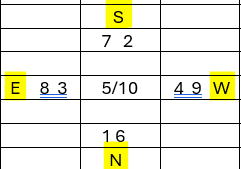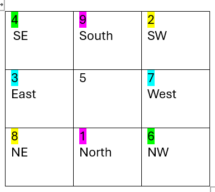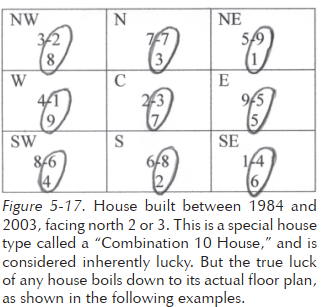
This marks my second follow-up article regarding Feng Shui concepts mentioned in Wilheim Reich Lippelt’s book, Feng Shui Demystified. If mathematics and music are universal languages, we can also note that there are primordial observations about energy, the cosmos, and creation which permeate all metaphysical disciplines. The Fibonacci series can be found in nature virtually anywhere and the Ho Tu (aka He Tu) Numbers from Feng Shui suggest a certain order to the universe as well.
In some applications of Feng Shui, we note which star (aka number) combinations are supposed to be extra-ordinary or meaningful, but some teachers fall short of explaining the origins. We practitioners scratch our heads wondering why a certain “house type” is deemed special, without much of a reference point.
In the arrangement of the Ho Tu Numbers (also written as He Tu), we see a placement of the stars as code for energy, united in a pattern on the cardinal directions.
When those star combinations pair up in a flying star chart, they imply significance, especially if the pattern exists in certain directions or in every direction. We have 81 different pairings of the Mountain Dragon star and the Water Dragon star. Just eight of those combinations would be deemed Ho Tu Number pairings. Those would be: 1-6, 6-1, 2-7, 7-2, 3-8, 8-3, 4-9, 9-4.
Each of these pairings has in common the number 5, such as 6-1=5, 7-2=5, 8-3=5, 9-4=5.
We also need to have an appreciation for the 5 star in order to understand the significance of Feng Shui’s own brand of numerology. All the stars are considered different manifestations of the 5 star, in the way that DNA gets passed down to relatives.
In the Ho Tu arrangement, which precedes the development of the Later Heaven Sequence, we find:
1,6 in the North (Water)
2,7 in the South (Fire)
3,8 in the East (Wood)
4,9 in the West (Metal)
The numbers 5 and 10 represent the center, which is no direction. We can contemplate this further including how the human body has 5 fingers on each hand and how important the number 10 is in mathematics.
Let’s take the 2,7 combination, related to fire as an example. In the Later Heaven Sequence, the 2 star is associated with earth and 7 with metal. And yet, if the 2-7 combination exists in someone’s house in the south sector, we learn that this house type is prone to having a fire accident. This references back to the Ho Tu, where 2 and 7 are positioned in the South and South is related to fire.
I once lived in a house with this combination and one day I almost started a fire in the kitchen. I had placed a pan on the stove and didn’t know that a napkin had been stuck to the bottom of the pan before I put the burner on! Fortunately, I had not left the kitchen and got the fire out quickly. Interestingly, my western astrologer friend had told me six months previous that I might have a fire the first week in December, which is exactly when this occurred.
With Feng Shui, there is also a bit of mysterious alchemy present, such as how 4 wood and 9 fire together can create “metal,” but if we trace back to the Ho Tu Number combination, it becomes more obvious how this could be. Not all houses have the Ho Tu Number combinations represented, but here is a chart for a West-1 facing/ East-1 sitting Period 5 house:

You can see the Ho Tu combinations 6-1 in NE, 8-3 in North, 9-4 in SW and 7-2 in South, indicating potential for a literal fire.
With the Luo Shu Magic Square referred to constantly in Flying Star Feng Shui, we note how all the numbers in each column up and down and diagonal add up to 15. With the opposing cardinal directions, minus the 5 star as the “operator,” they all add up to 10. In “recreational” mathematics, this is one of many magic squares. See Wikipedia for more historical references. It is the Saturn Square, which is used in Feng Shui.

Minus the 5 in the center we can see instantly how from east to west we have 3 + 7=10. Or from north to south we have 1 + 9= 10. Now we observe another dynamic where there is directional pole magnetism between 4 (SE) and 6 (NW), 2 (SW) and 8 (NE) as well. All pairings add up to 10.
This leads into why there is a Special House type called the “Sum of 10” house or Combination 10 chart. Take note of the following chart. It is just one example.

Out of 144 different flying star charts, there are 24 which have the Sum of 10 configuration. In order for a chart to be a Sum of 10 chart, we have to see that the pairing of the Period star and the Mountain Dragon or the Period star and the Water Dragon add up to 10. When the Sum of 10 is with the Mountain Dragon, this is supposed to be a house that is especially lucky for the occupant’s health and well-being. If the Sum of 10 is between the Period star and the Water Dragon (as shown in Figure 5-17), then it is supposed to be especially lucky for wealth and finances.
As with all house types, including all “Special House Types,” we still have to consider who is living there and what time frame we are in. Some schools teach that a Special House type, like the Sum of 10 House, is only lucky during the Period it was built in. We also have to look at competing factors in the whole Feng Shui analysis.
For example: Is a Sum of 10 House lucky while it is in a 20 year Locked Phase? Is a Sum of 10 House lucky if it exists next to a cemetery or across the street from a junk yard? We absolutely have to consider other important features with the interiors and exteriors. Otherwise, the very notion of a Special House type in a void is “much ado about nothing.”
Author: Kartar Diamond
Company: Feng Shui Solutions ®
From the Feng Shui Theory Blog Series

